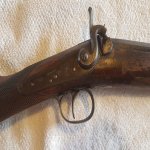These are Birmingham proof marks, so your gun is not a Belgian copy of a Moore gun (there were many). The mark to the left of the "14" is the view mark, and the mark to the right is the Birmingham Company Proof mark for black powder. These marks were in use from 1813 to 1904. The "14" is the bore size.
In researching a gun made by William Moore, I can say yours is not one of his - his guns carry a variety of markings, but none are just "Moore" (namely 'William Moore', 'W. Moore', 'Wm. Moore', W.M. & Co.', 'William Moore & Co.', Wm. Moore & Wm. Grey', and so on).
Considering your gun is likely to have been made in the 1840s or 1850s, a possibility is that it was made by John Moore of Wallingford, Berkshire, who was in business in 1846-1848 (and again in 1868, but unlikely to have continued making muzzle-loaders then). I can't find any other "Moore" from that period whose name would be on a finished gun.
While it is odd there is no name and/or address on the barrel, it is not unheard of. Anything is possible in 19th century British gunmaking. While it is possible that Moore made the gun from Birmingham sourced parts, it is also possible that he bought the gun partly or wholly finished from a Birmingham maker, and added his name to the lock for final sale. The name on a gun from that period is always the final retailer, usually the final finisher, and only sometimes the actual maker.
Enjoy owning a nice piece of history.
Edit: I found another John Moore, gunmaker at Middle Street, Ripon, Yorkshire from 1840-1857.





















































































